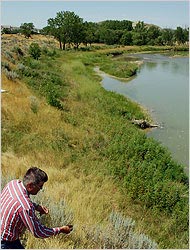Biblio
Several million gallons of "frack" fluid for each well return to the surface as a heavy brine, far saltier than seawater. Disposal of these new volumes of brine is a challenge.
So far, well operators or their agents have been hauling most of the frack flowback to Ohio for underground injection, according to Peterson, because salt removal is expensive and only two Class II, or brine disposal, wells were permitted by West Virginia's Underground Injection Control program.
Now, though, nine commercial brine disposal injection wells are permitted, and seven are operating. Several more are in the permitting pipeline.
The DEP has not in the past required well operators to report their water management in detail.
See: Desalination of Oil Field Brine
See: Gas wells' leftovers may wash into Ohio | Columbus Dispatch Politics
"Of the 84,000 chemicals in commercial use in the United States -- from flame retardants in furniture to household cleaners -- nearly 20 percent are secret, according to the Environmental Protection Agency, their names and physical properties guarded from consumers and virtually all public officials under a little-known federal provision."
WASHINGTON COUNTY, PA - At first, farmer Ron Gulla and horse farm owner Joyce Mitchell were excited about the prospect of making money from gas drilling. Now, after more than two years of the presence of drilling companies with their heavy trucks and huge drill rigs, they and many of their neighbors wish they had never signed a lease.
Gasses bubbling out of the ground and into drinking wells and ponds. Before drilling is begun, a landowner should have the water tested for baseline items, he said. “The only problem is that such tests can be very costly.”
Pennsylvania Gov. Ed Rendell on Thursday proposed new rules to strengthen state regulation of natural gas drilling to protect drinking water supplies and announced the hiring of 68 new inspectors.
[Regulations] would require energy companies to restore or replace water supplies affected by drilling; require operators to notify regulators of any leakage of gas into water wells; and direct drillers to construct well casings from oilfield-grade cement designed to prevent leakage of drilling fluid into underground water supplies.
To bolster enforcement, the state's Department of Environmental Protection was hiring 68 new inspectors in addition to the 120 already on staff.
Pennsylvania officials say energy companies have applied for 5,200 permits in the Marcellus Shale this year, almost triple the number in 2009, as drillers scramble to develop the huge gas field underlying about two-thirds of Pennsylvania and parts of surrounding states.
"...Walter Hang, president of Ithaca-based Toxics Targeting Inc., has been working with Pulteney residents on the wastewater issue. Even with Chesapeake's decision, the Pulteney saga proves this is a problem that has not been adequately addressed by DEC and others, Hang said.
-----"That was obviously a ridiculously bad location to put a deep well injection facility," he said. "Why would you ship that water hundreds of miles to the middle of nowhere and move it to within a mile of this historic jewel of a Finger Lake?""
State Assemblywoman Barbara Lifton wants to slow it down. Sen. Thomas Libous is for speeding it up. Assemblywoman Donna Lupardo is torn between extremes.
Elected officials taking a position on Marcellus Shale development are facing strident demands from stakeholders who could become rich, go broke or possibly abandon hope, depending on Albany's response...
...Deborah Goldberg, an attorney with Earthjustice, an environmental law firm, said the final SGEIS must include substantial changes to account for the cumulative effect of drilling thousands and perhaps tens of thousands of Marcellus wells in New York. If not, the firm will help spearhead a legal challenge, most likely in state Supreme Court in Albany.
That would involve filing an Article 78 Proceeding challenging the DEC's adherence to the State Environmental Quality Review Act.
Residents near gas leak still live in fear.
You never know from day to day what is going to happen," Mrs. McGee said of their situation. "You have no idea how a gas well will affect your life."
Everything now, from shopping to doctors' appointments and vacations, have to be planned around what is happening with the gas-level readings in their home, she said. "Our lives are not our own."
They have 100 percent readings of the lower explosive levels every week, Mrs. McGee said. They are being told they are safe, as long as the house is vented but are worried about what would happen if the vents accidentally are blocked, she said.
When the McGees first experienced what they call a "black goo" in their water, she said, "they tried to convince us it was perfectly normal."
New York Times Editorial. Published: November 2, 2009.
Among the many dubious provisions in the 2005 energy bill was one dubbed the Halliburton loophole, which was inserted at the behest of — you guessed it — then-Vice President Dick Cheney, a former chief executive of Halliburton.
It stripped the Environmental Protection Agency of its authority to regulate a drilling process called hydraulic fracturing. Invented by Halliburton in the 1940s, it involves injecting a mixture of water, sand and chemicals, some of them toxic, into underground rock formations to blast them open and release natural gas.
Hydraulic fracturing has been implicated in a growing number of water pollution cases across the country. It has become especially controversial in New York, where regulators are eager to clear the way for drilling in the New York City watershed, potentially imperiling the city’s water supply. Thankfully, the main company involved has now decided not to go ahead.
The safety of the nation’s water supply should not have to rely on luck or the public relations talents of the oil and gas industry. Thanks in part to two New Yorkers — Representative Maurice Hinchey and Senator Charles Schumer — Congress last week approved a bill that asks the E.P.A. to conduct a new study on the risks of hydraulic fracturing. An agency study in 2004 whitewashed the industry and was dismissed by experts as superficial and politically motivated. This time Congress is demanding “a transparent, peer-reviewed process.”
The quality of drinking water is an urgent concern for over forty million people who live in proximity to the Marcellus Shale.
"The 35-year-old federal law regulating tap water is so out of date that the water Americans drink can pose what scientists say are serious health risks — and still be legal.
Only 91 contaminants are regulated by the Safe Drinking Water Act, yet more than 60,000 chemicals are used within the United States, according to Environmental Protection Agency estimates. Government and independent scientists have scrutinized thousands of those chemicals in recent decades, and identified hundreds associated with a risk of cancer and other diseases at small concentrations in drinking water, according to an analysis of government records by The New York Times.
But not one chemical has been added to the list of those regulated by the Safe Drinking Water Act since 2000.
Other recent studies have found that even some chemicals regulated by that law pose risks at much smaller concentrations than previously known. However, many of the act’s standards for those chemicals have not been updated since the 1980s, and some remain essentially unchanged since the law was passed in 1974."
by Abrahm Lustgarten, ProPublica - April 7, 2010.
Series: Buried Secrets: Gas Drilling's Environmental Threat.
A federal study of hydraulic fracturing set to begin this spring is expected to provide the most expansive look yet at how the natural gas drilling process can affect drinking water supplies, according to interviews with EPA officials and a set of documents outlining the scope of the project.
The research will take a substantial step beyond previous studies and focus on how a broad range of ancillary activity – not just the act of injecting fluids under pressure – may affect drinking water quality.
The oil and gas industry strongly opposes this new approach. The agency’s intended research "goes well beyond relationships between hydraulic fracturing and drinking water," said Lee Fuller, vice president of government affairs for the Independent Petroleum Association of America in comments (PDF) he submitted to the Environmental Protection Agency.
See 22 page Powerpoint, Hydraulic Fracturing Applicability of the Safe Drinking Water Act and Clean Water Act Science Advisory Board Discussion.(2010).
Philadelphia Enquirer editorial. Published: Mar. 22, 2010.
...Representatives of the Marcellus Shale Coalition, an industry trade group, point out that not a single case of groundwater contamination has been linked to their drilling technique, called hydraulic fracturing or "fracking."
It involves pumping up to three million gallons of water (per well), combined with sand and chemicals, more than a mile underground to shatter the rock and release the gas.
But fracking does carry potential risks to the environment. Those concerns are causing government officials elsewhere to proceed cautiously on Marcellus drilling. New York state has imposed a moratorium on Marcellus wells until it completes an environmental-impact assessment.
Jim Robbins. September 10, 2006. New York Times.
It is a strange fight, Montana ranchers say. Raising cattle here in the parched American outback of eastern Montana and Wyoming has always been a battle to find enough water.
Now there is more than enough water, but the wrong kind, they say, and they are fighting to keep it out of the river.
Mark Fix is a family rancher whose cattle operation depends on water from the Tongue River. Mr. Fix diverts about 2,000 gallons per minute of clear water in the summer to transform a dry river bottom into several emerald green fields of alfalfa, an oasis on dry rangeland. Three crops of hay each year enable him to cut it, bale it and feed it to his cattle during the long winter.
“Water means a guaranteed hay crop,” Mr. Fix said.
But the search for a type of natural gas called coal bed methane has come to this part of the world in a big way. The gas is found in subterranean coal, and companies are pumping water out of the coal and stripping the gas mixed with it. Once the gas is out, the huge volumes of water become waste in a region that gets less than 12 inches of rain a year.

Mark Fix, a cattle rancher in eastern Montana, diverts about 2,000 gallons per minute of Tongue River water in the summer to grow hay for his livestock. But increased sodium in the water could endanger his hayfields.
See: Molly Ivins. (2004) C-Span Book TV Oct. 2, 2004. Bushwacked: Life in George W. Bush's America. Chapter: "Dick, Dubya, and Wyoming Methane." (152)
Mike Dennison. March 18, 2010. Billings Gazette.
"The state Land Board, undeterred by anti-mining protesters who disrupted the board’s Helena meeting for 45 minutes until they were arrested, voted 3-2 Thursday to approve leasing 570 million tons of state-owned coal for development of a mine in southeastern Montana’s Otter Creek Valley.
The vote by the five-member Land Board approved an $85.8 million up-front bid on the coal by Arch Coal Inc., giving the St. Louis-based mining giant a 10-year window to develop a mine in the pristine valley 150 miles east of Billings.
Gov. Brian Schweitzer, who voted for leasing the coal, extolled the long-term economic benefits of a new coal mine in the valley, saying it would bring $5 billion in tax revenue and royalties over the life of a mine and approximately $250 million a year once the mine is operating...
...The vote came after five protesters disrupted the meeting by chanting “Hands off Otter Creek — you’re not listening!” as McCulloch made a motion to vote to approve the lease.
The protesters, who had been sitting in the front row of chairs in the packed meeting room, stood and then linked arms as they sat on the floor, chanting, about 20 feet from the board members.
Schweitzer recessed the meeting and Helena Police officers ordered the room cleared, as they waited for other officers to arrive and assist with arresting the protesters. About 45 minutes later, police had handcuffed and arrested the protesters and taken them to the Lewis and Clark County jail to book them on misdemeanor charges of disorderly conduct."
Genevieve Schroder is removed from the State Land Board meeting Thursday in the Capitol. Schroder and four other Missoula residents were arrested after protesting the leasing of the state-owned Otter Creek coal. (Courtesy photo)


















